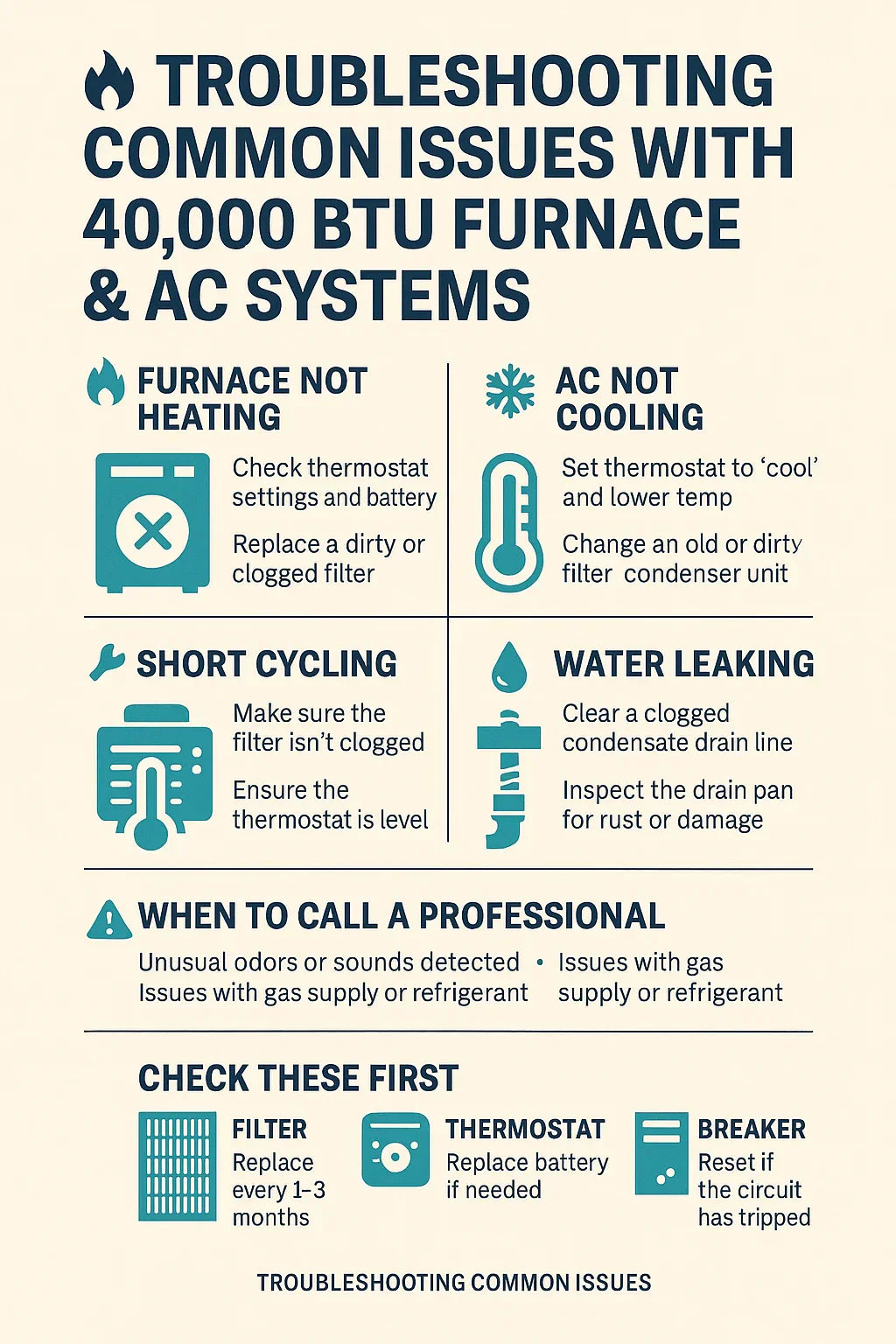A Mark Callahan Practical Guide to Fixing Issues Before Calling a Pro
🔍 Why Troubleshooting Matters Before Calling a Pro
Troubleshooting your 40,000 BTU furnace and AC system:
-
Saves money by fixing simple issues without a service call.
-
Helps you communicate clearly with a technician.
-
Prevents minor issues from becoming major repairs.
See Energy Star HVAC Maintenance for prevention and troubleshooting basics.
🔥 Common Furnace Issues and DIY Checks
Furnace Not Heating:
-
Check thermostat settings (heat mode, temperature).
-
Ensure the furnace switch and breaker are on.
-
Inspect the filter; replace if dirty.
-
Check for error codes on the control board.
Short Cycling:
-
Dirty filters restricting airflow.
-
Thermostat placement near heat sources.
-
Oversized systems causing rapid cycling.
Strange Noises:
-
Rattling: Loose panels or screws.
-
Squealing: Blower belt issues.
-
Banging: Delayed ignition or duct expansion.
Pilot Light or Ignition Issues:
-
Check if the gas supply is on.
-
Inspect flame sensor and clean if accessible.
-
Verify error codes for ignition lockout issues.
See Carrier’s Furnace Troubleshooting Guide for additional steps.
❄️ Common AC Issues and DIY Checks
AC Not Cooling:
-
Check thermostat (set to cool, correct temperature).
-
Ensure outdoor unit is running.
-
Inspect air filter.
-
Check for ice buildup on coils.
Weak Airflow:
-
Replace dirty filters.
-
Check for blocked vents.
-
Inspect ductwork for leaks or obstructions.
Water Leaks:
-
Clogged condensate drain line.
-
Inspect drain pan for cracks.
Strange Noises:
-
Buzzing: Electrical issues.
-
Clanking: Loose parts in the compressor or fan.
-
Hissing: Possible refrigerant leak.
For reference, review Trane’s AC Troubleshooting Guide.
🛠️ First Steps: Filters, Thermostat, Breakers
✅ Filters: Replace if dirty; a clogged filter is a common cause of airflow issues and system shutdowns.
✅ Thermostat: Check batteries, settings, and mode.
✅ Breakers: Check electrical panel for tripped breakers; reset if safe.
These steps resolve many common issues quickly.
💡 Understanding Error Codes on Your System
Most modern systems have LED error codes on the control board.
-
Goodman: LED blinks in a pattern indicating the issue.
-
Carrier and Trane: Similar LED indicators.
Find the error code chart on your furnace door or in your user manual for interpretation.
⚠️ Safety Warnings During Troubleshooting
-
Smell of gas: Turn off the system immediately, leave your home, and call the gas company.
-
Electrical smells or sparks: Shut off power at the breaker; call a professional.
-
Never bypass safety switches or panels during troubleshooting.
👷 When to Call a Professional
✅ Call a professional if:
-
You detect a gas smell.
-
Electrical breakers trip repeatedly.
-
You suspect a refrigerant leak.
-
The system shows persistent error codes despite resets.
-
You hear loud banging or grinding noises.
-
Short cycling persists after filter changes.
Hiring a professional ensures safe and correct repairs.
🧹 Preventive Steps to Avoid Future Issues
-
Change filters every 1–3 months.
-
Keep outdoor units clear of debris.
-
Schedule annual HVAC maintenance.
-
Check thermostat operation seasonally.
-
Keep vents and registers unobstructed.
Following these steps helps your system run efficiently and reduces emergency breakdowns.
🪙 How Troubleshooting Saves Money
✅ Avoids unnecessary service calls ($100–$300 per visit). ✅ Prevents small issues from becoming expensive repairs. ✅ Helps you understand your system for better maintenance.
Troubleshooting is a practical first step in managing your system like Mark Callahan.
📝 Conclusion
Troubleshooting your 40,000 BTU furnace and AC system before calling a pro can:
-
Save money.
-
Help you learn about your system.
-
Resolve minor issues quickly.
For Mark Callahan and homeowners aiming to manage comfort and efficiency, these steps ensure your system stays reliable throughout the year.
If you need replacement parts or to upgrade, see The Furnace Outlet’s 40,000 BTU Systems for options compatible with your home.
In the next topic we will know more about: Understanding SEER2 Ratings on 40,000 BTU AC Systems – What They Mean for Efficiency and Your Bills







